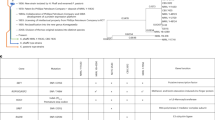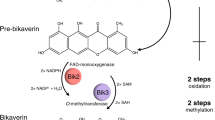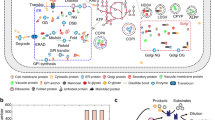Abstract
Yeast and fungal protein expression systems are used for the production of many industrially relevant enzymes, and are widely used by the research community to produce proteins that cannot be actively expressed in Escherichia coli or require glycosylation for proper folding and biological activity. However, for the production of therapeutic glycoproteins intended for use in humans, yeasts have been less useful because of their inability to modify proteins with human glycosylation structures. Yeast glycosylation is of the high-mannose type, which confers a short in vivo half-life to the protein and may render it less efficacious or even immunogenic. Several ways of humanizing yeast-derived glycoproteins have been tried, including enzymatically modifying proteins in vitro and modulating host glycosylation pathways in vivo. Recent advances in the glycoengineering of yeasts and the expression of therapeutic glycoproteins in humanized yeasts have shown significant promise, and are challenging the current dominance of therapeutic protein production based on mammalian cell culture.
This is a preview of subscription content, access via your institution
Access options
Subscribe to this journal
Receive 12 print issues and online access
$209.00 per year
only $17.42 per issue
Buy this article
- Purchase on Springer Link
- Instant access to full article PDF
Prices may be subject to local taxes which are calculated during checkout



Similar content being viewed by others
References
Walsh, G. Biopharmaceutical Benchmarks—2003. Nat. Biotechnol. 21, 865–870 (2003).
Punt, P.J., van Biezen, N., Conesa, A., Albers, A., Mangnus, J. & van den Hondel, C. Filamentous fungi as cell factories for heterologous protein production. Trends Biotechnol. 20, 200–206 (2002)
Werten, M.W.T., van den Bosch, T.J., Wind, R.D., Mooibroek, H. & De Wolf, F.A. High-yield secretion of recombinant gelatins by Pichia pastoris. Yeast 15, 1087–1096 (1999).
Humphreys, A. & Boersig, C. Cholesterol drugs dominate. MedAdNews 22, 42–57 (2003).
Coloma, M.J., Clift, A., Wims, L. & Morrison, S.L. The role of carbohydrate in the assembly and function of polymeric IgG. Mol Immunol. 37, 1081–1090 (2000).
Mistry, P.K., Wraight, E.P. & Cox, T.M. Therapeutic delivery of proteins to macrophages: implications for treatment of Gaucher's disease. The Lancet, 348, 1555–1559 (1996).
Grabowski, G.A. et al. Enzyme therapy in type 1 Gaucher disease: comparative efficacy of mannose-terminated glycocerebrosidase from natural and recombinant sources. Ann. Intern. Med. 122, 33–39 (1995).
Grabenhorst, E., Schlenke, P., Pohl, S., Nimtz, M. & Conradt, H.S. Genetic engineering of recombinant glycoproteins and the glycosylation pathway in mammalian host cells. Glyconj. J. 16, 81–97 (1999).
Suzuki, T., Kitajima, K., Inoue, S. & Inoue, Y. N-glycosylation/deglycosylation as a mechanism for the post-translational modification/remodification of proteins. Glycoconj J. 12, 189–193 (1995).
Takeuchi, M. et al. Relationship between sugar chain structure and biological activity of recombinant human erythropoietin produced in Chinese hamster ovary cells. Proc. Natl. Acad. Sci. USA. 86, 7819–7822 (1989).
Yuen, C.T. et al. Relationships between the N-glycan structures and biological activities of recombinant human erythropoietins produced using different culture conditions and purification procedures. Br. J. Haematol. 121, 511–526 (2003).
Erbayraktar, S. et al. Asialoerythropoietin is a nonerythropoietic cytokine with broad neuroprotective activity in vivo. Proc. Natl. Acad. Sci. USA 100, 6741–6746 (2003). Erratum in: Proc. Natl. Acad. Sci. USA 100, 9102 (2003).
Friedman, B. et al. A comparison of the pharmacological properties of carbohydrate remodeled recombinant and placental-derived beta-glucocerebrosidase: implications for clinical efficacy in treatment of Gaucher disease. Blood 93, 2807–2816 (1999).
Umana, P., Jean-Mairet, J., Moudry, R., Amstutz, H. & Bailey, J.E. Engineered glycoforms of an antineuroblastoma IgG1 with optimized antibody-dependent cellular cytotoxic activity. Nat. Biotechnol. 17, 176–180 (1999).
Warner, T.G. Enhancing therapeutic glycoprotein production in Chinese hamster ovary cells by metabolic engineering endogenous gene control with antisense DNA and gene targeting. Glycobiology 9, 841–850 (1999).
Warner, T.G. Metabolic engineering glycosylation: biotechnology's challenge to the glycobiologist in the next millennium. in Part IV Biology of Saccharides. (eds. Ernst, B., Hart, G. & Sinay, P.) 1043–1064 (VCH-Wiley, New York, 2001).
Cregg, J.M., Cereghino, J.L., Shi, J. & Higgins, D.R. Recombinant protein expression in Pichia pastoris. Mol. Biotechnol. 16, 23–52 (2000).
Mochizuki, S. et al. Expression and characterization of recombinant human antithrombin III in Pichia pastoris. Protein Expr. Purif. 23, 55–65 (2001).
Ward, M. et al. Characterization of humanized antibodies secreted by Aspergillus niger. Appl. Environ. Microbiol. 70, 2567–2576 (2004).
Ogunjimi, A.A., Chandler, J.M., Gooding, C.M., Recinos, A. & Choudary, P.V. High-level secretory expression of immunologically active intact antibody from the yeast P. pastoris. Biotechnol. Letters, 21, 561–567 (1999).
Maras, M. & Contreras, R. Methods for modifying carbohydrate moieties. US patent 5,834,251 (Dec. 30, 1994).
Maras, M. et al. In vitro conversion of the carbohydrate moiety of fungal glycoproteins to mammalian-type oligosaccharides. Eur. J. Biochem. 249, 701–707 (1997).
Kornfeld, R. & Kornfeld, S. Assembly of asparagine-linked oligosaccharides. Annu. Rev. Biochem. 54, 631–664 (1985).
Brockhausen, I., Carver, J.P. & Schachter, H. Control of glycoprotein synthesis. The use of oligosaccharide substrates and HPLC to study the sequential pathway for N-acetylglucosaminyltransferases I, II, III, IV, V and VI in the biosynthesis of highly branched N-glycans by hen oviduct membranes. Biochem. Cell Biol. 66, 1134–1151 (1988).
Silberstein, S. & Gilmore, R. Biochemistry, molecular biology and genetics of oligosaccharyltransferase. FASEB J. 10, 849–858 (1996).
Gemmill, T.R. & Trimble, R.B. Overview of N- and O-linked oligosaccharide structures found in various yeast species. Biochim. Biophys. Acta 1426, 227–237 (1999).
Tulsiani, D.R., Hubbard, S.C., Robbins, P.W. & Touster, O. Alpha-D-mannosidases of rat liver Golgi membranes. Mannosidase II is the GlcNAcMan5-cleaving enzyme in glycoprotein biosynthesis and mannosidases IA and IB are the enzymes converting Man9 precursors to Man5 intermediates. J. Biol. Chem. 257, 3660–3668 (1982).
Kalsner, I., Hintz, W., Reid, L.S. & Schachter, H. Insertion into Aspergillus nidulans of functional UDP-GlcNAc: α3-D-mannoside β-1,2-N-acetyl-glucosaminyltransferase I, the enzyme catalyzing the first committed step from oligomannose to hybrid and complex N-glycans. Glycoconj. J. 12, 360–370 (1995).
Martinet, W., Maras, M., Saelens, X., Jou, W.M. & Contreras, R. Modification of the protein glycosylation pathway in the methylotrophic yeast, Pichia pastoris. Biotechnol. Letters 20, 1171–1177 (1998).
Chiba, Y. et al. Production of human compatible high mannose-type (Man5GlcNAc2) sugar chains in Saccharomyces cerevisiae. J. Biol. Chem. 273, 26298–26304 (1998).
Choi, B.K. et al. Use of combinatorial genetic libraries to humanize N-linked glycosylation in the yeast Pichia pastoris. Proc. Natl. Acad. Sci. USA 100, 5022–5027 (2003).
Stadheim, T.A., Bobrowicz, P. & Wildt, S. Methods for eliminating mannosylphosphorylation of glycans in the production of glycoproteins. US Patent Appl. No. 60/532,461 (December 23, 2003).
Vervecken, W. et al. In vivo synthesis of mammalian-like, hybrid-type N-glycans in Pichia pastoris. Appl Environ Microbiol. 70, 2639–2646 (2004).
Hamilton, S.R. et al. Production of complex human glycoproteins in yeast. Science, 301, 1244–1246 (2003).
Bobrowicz, P. et al. Engineering of an artificial glycosylation pathway blocked in core oligosaccharide assembly in the yeast Pichia pastoris: production of complex humanized glycoproteins with terminal galactose. Glycobiology 14, 757–766 (2004).
Author information
Authors and Affiliations
Corresponding author
Ethics declarations
Competing interests
T.U.G. has equity exceeding 5% in a company (GlycoFi) that develops yeast-based protein expression systems.
Rights and permissions
About this article
Cite this article
Gerngross, T. Advances in the production of human therapeutic proteins in yeasts and filamentous fungi. Nat Biotechnol 22, 1409–1414 (2004). https://doi.org/10.1038/nbt1028
Published:
Issue Date:
DOI: https://doi.org/10.1038/nbt1028
This article is cited by
-
Construction of a novel filamentous fungal protein expression system based on redesigning of regulatory elements
Applied Microbiology and Biotechnology (2022)
-
Engineering of Plants for Efficient Production of Therapeutics
Molecular Biotechnology (2021)
-
Protein expression and secretion by filamentous fungi
Journal of Biosciences (2021)
-
Design of an improved universal signal peptide based on the α-factor mating secretion signal for enzyme production in yeast
Cellular and Molecular Life Sciences (2021)
-
A Novel Human Recombinant Lactoferrin Inhibits Lung Adenocarcinoma Cell Growth and Migration with No Cytotoxic Effect on Normal Human Epithelial Cells
Archivum Immunologiae et Therapiae Experimentalis (2021)



